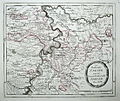Prince-Bishopric of Speyer
This article relies largely or entirely on a single source. (November 2018) |
Prince-Bishopric of Speyer Episcopatus Spirensis () | |||||||||||
|---|---|---|---|---|---|---|---|---|---|---|---|
| 888–1803 | |||||||||||
France and Baden | 1801–03 1803 | ||||||||||
| |||||||||||
The Prince-Bishopric of Speyer, formerly known as Spires in English, (German: Hochstift Speyer, Fürstbistum Speyer, Bistum Speyer) was an ecclesiastical principality in what are today the German states of
Geography
The Prince-Bishopric of Speyer belonged to the Upper Rhenish Circle of the Holy Roman Empire. One of the smallest principalities of the Holy Roman Empire, it consisted of more than half a dozen separate enclaves totalling about 28 German square miles (about 1540 km2) on both sides of the Rhine. It included the towns of Bruchsal (on the right bank) as well as Deidesheim, Herxheim bei Landau, and Lauterburg (on the left bank). Around 1800 the bishopric included about 55,000 people.
History
A diocese of Speyer has possibly existed since the 3rd or 4th century. It was first mentioned in historical documents in 614. Up to 748 it was a suffragant bishopric of the archdiocese of Trier, and from then until the secularisation of the prince-bishopric in 1803, of the archdiocese of Mainz.
The history of the Bishopric of Speyer began at the latest in the late 7th century when the bishop of
From 1111 the citizens of the city of Speyer began to increasingly loosen their bonds to the rulership of the bishop. In 1230 a
French troops captured Philippsburg in 1644 during the later stages of the
In 1801/1802, the
This ended the secular responsibilities of the bishop of Speyer. The secularized bishopric continued ecclesiastically as the
-
The Bishop's palace next to Speyer Cathedral (1765)
-
Udenheim Castle (main residence of the bishops from 1371)
-
Bruchsal Palace (main residence from 1723)
-
Bishopric of Speyer 1793/93
List of bishops
See also
Footnotes
- ^ Franck Lafarge, Les comtes Schönborn, 1642-1756, L'Harmattan, Paris, 2008, vol. 2, p. 349-350.








